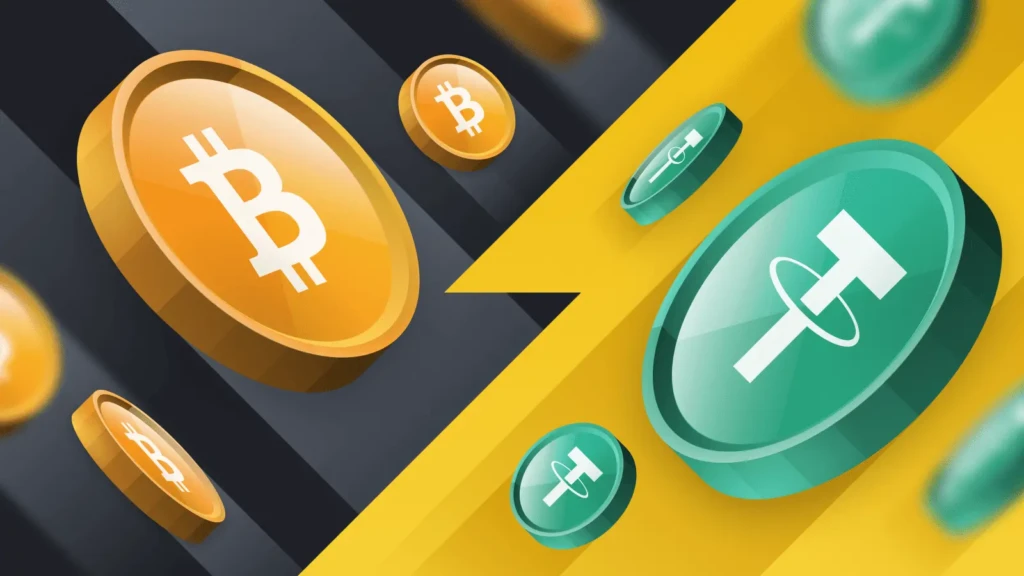No, USDT (Tether) is not pegged to Bitcoin. Instead, it is a stablecoin designed to maintain a 1:1 peg with the U.S. dollar. This means that each USDT token is intended to be worth one U.S. dollar, providing a stable digital asset for transactions and trading in the volatile cryptocurrency market.
Understanding USDT and Its Peg Mechanism
What Is USDT?
Tether (USDT) is a cryptocurrency stablecoin launched in 2014. Initially issued on the Bitcoin blockchain via the Omni Layer, USDT has since expanded to multiple blockchains, including Ethereum, TRON, and Solana. Its primary purpose is to offer a stable digital asset that mirrors the value of the U.S. dollar, facilitating smoother transactions and serving as a hedge against the volatility of cryptocurrencies like Bitcoin.
How Is USDT Pegged?
Tether maintains its peg to the U.S. dollar through a reserve system. For every USDT issued, Tether claims to hold an equivalent amount in reserves, which may include cash, cash equivalents, and other assets. This reserve backing is intended to ensure that USDT can be redeemed at a value of one U.S. dollar. However, the transparency and sufficiency of these reserves have been subjects of scrutiny and regulatory attention.
The Relationship Between USDT and Bitcoin
Tether’s Bitcoin Holdings
While USDT is not pegged to Bitcoin, Tether has accumulated a significant amount of Bitcoin in its reserves. As of early 2025, Tether held over 100,000 BTC, making it one of the largest holders of Bitcoin among corporate entities. This strategy appears to be a move to diversify its reserve assets and potentially leverage Bitcoin’s value appreciation. However, this also introduces exposure to Bitcoin’s price volatility, which could impact the stability of USDT if Bitcoin’s value declines significantly.
Bitcoin’s Role in Tether’s Strategy
Tether’s investment in Bitcoin serves multiple purposes. It acts as a hedge against inflation and currency devaluation, and provides a potential source of profit from Bitcoin’s price increases. Additionally, Tether’s involvement in Bitcoin mining operations, such as those in Paraguay, indicates a long-term commitment to the cryptocurrency ecosystem. However, this strategy also exposes Tether to risks associated with Bitcoin’s market fluctuations, which could affect the perceived stability of USDT.
Risks and Criticisms of Tether’s Peg
Reserve Transparency and Regulatory Scrutiny
Tether has faced criticism over the transparency of its reserve holdings. In 2021, the U.S. Commodity Futures Trading Commission (CFTC) fined Tether $41 million for misleading claims about its reserves. Despite efforts to improve transparency, concerns persist regarding the adequacy and composition of Tether’s reserves. These issues have attracted regulatory scrutiny from various jurisdictions, including the United States and the European Union.
Market Liquidity and Redemption Challenges
The liquidity of USDT in the market is another area of concern. In times of market stress, significant sell-offs of USDT can lead to price deviations from its $1 peg. For instance, during periods of high volatility, USDT has traded below its $1 value, indicating potential challenges in maintaining its peg under adverse market conditions. Additionally, the redemption process for USDT may involve fees and minimum thresholds, which could deter users from redeeming their tokens during times of market turmoil.
The Future of USDT and Its Peg
Potential for Decentralized Alternatives
The rise of decentralized finance (DeFi) and algorithmic stablecoins presents potential alternatives to USDT. These alternatives aim to provide stability without relying on centralized reserve systems. However, the effectiveness and reliability of these decentralized models remain to be fully tested in various market conditions.
Regulatory Developments and Market Dynamics
Ongoing regulatory developments will play a crucial role in shaping the future of USDT and other stablecoins. Regulations focusing on reserve transparency, redemption rights, and overall stability will influence the operational landscape for Tether. Additionally, market dynamics, including the adoption of alternative stablecoins and shifts in investor preferences, will impact USDT’s position in the cryptocurrency ecosystem.
FAQs
Q1: Is USDT pegged to Bitcoin?
No, USDT is pegged to the U.S. dollar, not Bitcoin. Each USDT token is intended to maintain a value of one U.S. dollar.
Q2: Does Tether hold Bitcoin in its reserves?
Yes, Tether holds a significant amount of Bitcoin in its reserves. As of early 2025, Tether owned over 100,000 BTC.
Q3: Can USDT’s peg to the U.S. dollar fluctuate?
While USDT aims to maintain a 1:1 peg to the U.S. dollar, market conditions and liquidity issues can cause temporary deviations from its $1 value.
Q4: What are the risks associated with USDT’s peg?
Risks include concerns over reserve transparency, potential liquidity challenges, and exposure to market volatility.
Q5: Will USDT continue to maintain its peg in the future?
The future stability of USDT’s peg depends on factors such as reserve management, regulatory compliance, and market conditions.
Conclusion
In conclusion, USDT is not pegged to Bitcoin but is a stablecoin designed to maintain a 1:1 peg with the U.S. dollar. While Tether holds significant Bitcoin reserves, this strategy introduces exposure to Bitcoin’s price volatility, which could impact the stability of USDT. The future of USDT’s peg will depend on effective reserve management, regulatory developments, and the evolving dynamics of the cryptocurrency market.

